A Novel Centralized Range-Free Static Node Localization Algorithm with Memetic Algorithm and Lévy Flight
Abstract
1. Introduction
- (1)
- A new optimization algorithm (LMQPSO) for node localization in WSN was reconstructed, in which we designed a fast search rule to speed up the convergence of LMQPSO. In addition, to escape from local optimum, MA and Lévy flight were both employed to enhance the global search ability. Furthermore, some other small operations, such as memory mechanism, were adopted to help to find the global solution.
- (2)
- By analyzing the error in the distance estimation of DV-Hop, we modified the calculating method of the average hop distance to reduce the error of the estimated distance among anchors.
- (3)
- By using LMQPSO to optimize the estimated distance, we provided a new efficient localization solution (LMQPDV-hop). LMQPDV-hop was compared to other competitive algorithms according to different densities of anchors and node communication ranges. The results confirm that the new algorithm achieved faster convergence and higher localization accuracy.
2. Related Work
3. Preliminaries
3.1. PSO
3.2. Memetic Algorithm
3.3. Lévy Flight
4. LMQPSO: The Proposed QPSO with the Memetic Algorithm and Lévy Flight
4.1. Skeleton of LMQPSO
| Algorithm 1. pseudo code of LMQPSO |
| Input: Np: number of particles; |
| D: the dimension of optimal problem; |
| Max_It: the maximum iteration |
| X_max,X_min: the rang of particle position |
| Output: Gbest |
| 1. Randomly initialize all particles, , for i = 1, 2, …, Np: |
| 2. Evaluate the fitness values; set X to be |
| 3. while iter < Max_It |
| 4. Sort all particles (descending) and divide them into m subgroups // seeing 4.1 for detail. |
| 5. Gbest = XNp; |
| 6. Mbest’(t) = 0; |
| 7. for k = 1 to le // Number of previous history memorized by Mbest’. the local search begin |
| 8. for i = 1 to m // For each subgroup |
| 9. Search the local Gbest’(t); |
| 10. Calculate the local attractor C’(t); //Using Equation (15) |
| 11. Calculate the local Mbest’(t); //Using Equations (18)~(19) |
| 12. for j = 1 to Np //Update each particle’s position in this subgroup |
| 13. if rand>=0.5 |
| 14. Calculate Using Equation (20) |
| 15. else |
| 16. Calculate with Lévy flight //Using Equation (21) |
| 17. end if |
| 18. Bound within [Xmax,Xmin] |
| 19. If is better than //Discarding the worse particle |
| 20. Update |
| 21. else |
| 22. Update |
| 23. end if |
| 24. end for // j |
| 25. end for //i |
| 26. Pbest = X |
| 27. Iter = iter+1 |
| 28. end for //k Finished the local search |
| 29. Gbest = Xi if Xi has the best fitness value//Global search to find the best solution |
| 30. end while |
4.2. Fast Local Search Rule
4.2.1. New Local Attractor Ci for Subgroup
4.2.2. New Definition of Mbest for Subgroup
4.2.3. Discarding Worse Particles
4.2.4. Synchronous Search for Each Dimension
4.3. Local Search with the Previous History Memorized by our New
4.4. Position Update with Lévy Flights
5. LMQPDV-Hop: The Proposed Localization Algorithm Based on LMQPSO and DV-Hop
5.1. Gathering Estimation Distances
5.1.1. Estimating Distance by DV-Hop
- (1)
- At the beginning, all nodes undergo bootstrapping process, in which each anchor broadcasts a HELLO packet that contains its node id, coordinate (initiate value is not null for anchors) and hop count (initiate value is 0) to the network. When a node receives the packet, it records the ID, the coordinate and the smallest hop count to each anchor, then it forwards the packet to its neighbors after hop values plus 1 until the packet reaches BS. In this way, all the nodes gather the smallest hop count to anchors.
- (2)
- When the BS receives all the packets from the network, it estimates the distances from each unknown node to all the anchors by using the following equation:where is the estimated distance between the unknown node and the anchor, is the smallest hop count, and is the average hop distance of the anchor and can be given bywhere is the smallest hop between anchor and anchor and is the coordinate of the anchor.
5.1.2. Improvement of the Estimated Distance
5.2. Optimization Localization Result
5.2.1. Initialization of Particles
5.2.2. The Fitness Function Derivation
5.2.3. Position Update
5.3. The Localization Flow of LMQPDV-hop
- Step 1.
- All nodes are deployed randomly in the regular or irregular target sensor field. At the beginning of the network initiation, namely, the neighbor discovery phase. The anchors calculate their location awareness and transmit their coordinates to the network. All nodes (anchors and unknown nodes) record the smallest hop counts to anchors and re-broadcast the information of these locations until it reaches the BS.
- Step 2.
- After BS receives all the location packages, it calculates the average distance using Equation 28. Subsequently, all the distances from the unknown nodes to the anchors are estimated using Equation (24).
- Step 3.
- Based on the distance matrix derived from the estimated dances, BS runs the proposed LMQPSO to solve the optimization model (i.e., Equation (31)) and determines the coordinates of unknown nodes.
6. Results and Analysis
6.1. Experiment 1
- (1)
- Sphere
- (2)
- Rastrigin
- (3)
- Rosenbrock
- (4)
- Griewank
6.2. Experiment 2
6.3. Simulation 1
6.4. Simulation 2
7. Conclusions
Author Contributions
Funding
Acknowledgments
Conflicts of Interest
References
- Rault, T.; Bouabdallah, A.; Challal, Y. Energy efficiency in wireless sensor networks: A top-down survey. Comput. Netw. 2014, 67, 104–122. [Google Scholar] [CrossRef]
- Han, G.; Xu, H.; Duong, T.Q.; Jiang, J.; Hara, T. Localization algorithms of Wireless Sensor Networks: A survey. Telecommun. Syst. 2013, 52, 2419–2436. [Google Scholar] [CrossRef]
- Girod, L.; Bychkovskiy, V.; Elson, J.; Estrin, D. Locating tiny sensors in time and space: A case study. In Proceedings of the IEEE International Conference on Computer Design: VLSI in Computers and Processors, Freiberg, Germany, 18 September 2002; pp. 214–219. [Google Scholar]
- Niculescu, D.; Badri, N. Ad hoc positioning system (APS) using AOA. In Proceedings of the IEEE INFOCOM 2003, Twenty-second Annual Joint Conference of the IEEE Computer and Communications Societies (IEEE Cat. No.03CH37428), San Francisco, CA, USA, 30 March–3 April 2003; Volume 3, pp. 1734–1743. [Google Scholar]
- Girod, L.; Estrin, D. Robust range estimation using acoustic and multimodal sensing. In Proceedings of the 2001 IEEE/RSJ International Conference on Intelligent Robots and Systems, Expanding the Societal Role of Robotics in the the Next Millennium (Cat. No.01CH37180), Maui, HI, USA, 29 October–3 November 2001; Volume 3, pp. 1312–1320. [Google Scholar]
- Niculescu, D.; Nath, B. Ad hoc positioning system (APS). In Proceedings of the GLOBECOM ’01, IEEE Global Telecommunications Conference, San Antonio, TX, USA, 25–29 November 2001; Volume 5, pp. 2926–2931. [Google Scholar]
- Bulusu, N.; Heidemann, J.; Estrin, D. GPS-less low cost outdoor optimization for very small devices. IEEE Pers. Commun. 2000, 7, 28–34. [Google Scholar] [CrossRef]
- He, T.; Huang, C.; Blum, B.M.; Stankovic, J.A.; Abdelzaher, T. Range-free localization schemes for large scale sensor networks. In Proceedings of the 9th Annual International Conference on Mobile Computing and Networking, San Diego, CA, USA, 14–19 September 2003; pp. 81–95. [Google Scholar]
- Sheu, J.P.; Chen, P.C.; Hsu, C.S. A Distributed Localization Scheme for Wireless Sensor Networks with Improved Grid-Scan and Vector-Based Refinement. IEEE Trans. Mob. Comput. 2008, 7, 1110–1123. [Google Scholar] [CrossRef]
- Kennedy, J.; Eberhart, R. Particle swarm optimization. In Proceedings of the IEEE International Conference on Neural Networks, Perth, Australia, 27 November–1 December 1995; Volume 4, pp. 1942–1948. [Google Scholar]
- Yang, X.S.; Deb, S. Cuckoo Search via Levey Flights. In Proceedings of the 2009 World Congress on Nature & Biologically Inspired Computing, Coimbatore, India, 9–11 December 2009; pp. 210–214. [Google Scholar]
- Yang, X.-S. A New Metaheuristic Bat-Inspired Algorithm. In Nature Inspired Cooperative Strategies for Optimization (NICSO 2010); González, J.R., Pelta, D.A., Cruz, C., Terrazas, G., Krasnogor, N., Eds.; Springer: Berlin, Germany, 2010; pp. 65–74. [Google Scholar]
- Liu, Y.; Chen, J.J.; Xu, Z.F. Improved DV-Hop Localization Algorithm Based on Bat Algorithm in Wireless Sensor Networks. KSII Trans. Internet Inf. Syst. 2017, 11, 215–236. [Google Scholar]
- Cui, Z.; Sun, B.; Wang, G.; Xue, Y.; Chen, J. A novel oriented cuckoo search algorithm to improve DV-Hop performance for cyber–physical systems. J. Parallel Distrib. Comput. 2017, 103, 42–52. [Google Scholar] [CrossRef]
- Zhang, Y.; Liang, J.; Jiang, S.; Chen, W. A Localization Method for Underwater Wireless Sensor Networks Based on Mobility Prediction and Particle Swarm Optimization Algorithms. Sensors 2016, 16, 212. [Google Scholar] [CrossRef] [PubMed]
- Zhao, Y.; Qian, Z.; Shang, X.; Cheng, C. PSO localization algorithm for WSN nodes based on modifying average hop distances. J. Commun. 2013, 34, 105–114. [Google Scholar]
- Cai, S.; Gao, Z.; Pan, H.; Shi, A. Localization Based on Particle Swarm Optimization with Penalty Function for Wireless Sensor Network. J. Comput. Res. Dev. 2012, 49, 1228–1234. [Google Scholar]
- Monica, S.; Ferrari, G. A swarm-based approach to real-time 3D indoor localization: Experimental performance analysis. Appl. Soft. Comput. 2016, 43, 489–497. [Google Scholar] [CrossRef]
- Cui, H.; Shu, M.; Song, M.; Wang, Y. Parameter Selection and Performance Comparison of Particle Swarm Optimization in Sensor Networks Localization. Sensors 2017, 17, 487. [Google Scholar] [CrossRef] [PubMed]
- Tang, D.; Cai, Y.; Zhao, J.; Xue, Y. A quantum-behaved particle swarm optimization with memetic algorithm and memory for continuous non-linear large scale problems. Inf. Sci. 2014, 289, 162–189. [Google Scholar] [CrossRef]
- Song, M.; Qian, J. Improved sequence-based localization applied in coal mine. Int. J. Distrib. Sens. Netw. 2016, 12. [Google Scholar] [CrossRef][Green Version]
- Li, Z.; Chung, P.-J.; Mulgrew, B. Distributed target localization using quantized received signal strength. Signal. Process. 2017, 134, 214–223. [Google Scholar] [CrossRef]
- Chowdhury, T.J.S.; Elkin, C.; Devabhaktuni, V.; Rawat, D.B.; Oluoch, J. Advances on localization techniques for wireless sensor networks: A survey. Comput. Netw. 2016, 110, 284–305. [Google Scholar] [CrossRef]
- Halder, S.; Ghosal, A. A survey on mobility-assisted localization techniques in wireless sensor networks. J. Netw. Comput. Appl. 2016, 60, 82–94. [Google Scholar] [CrossRef]
- Li, D.; Wen, X.B. An Improved PSO Algorithm for Distributed Localization in Wireless Sensor Networks. Int. J. Distrib. Sens. Netw. 2015, 11, 970272. [Google Scholar] [CrossRef]
- Sun, Z.; Tao, L.; Wang, X.; Zhou, Z. Localization Algorithm in Wireless Sensor Networks Based on Multiobjective Particle Swarm Optimization. Int. J. Distrib. Sens. Netw. 2015, 11, 716291. [Google Scholar] [CrossRef]
- Yang, J.; Tang, D.; Chen, W. Wireless Sensor Network Localization Algorithm Based on Improved Quantum-behaved Particle Swarm Optimization Algorithm. J. Comput. Inf. Syst. 2015, 11, 7563–7572. [Google Scholar]
- Goyal, S.; Patterh, M.S. Wireless Sensor Network Localization Based on Cuckoo Search Algorithm. Wirel. Pers. Commun. 2014, 79, 223–234. [Google Scholar] [CrossRef]
- Cheng, J.; Xia, L. An Effective Cuckoo Search Algorithm for Node Localization in Wireless Sensor Network. Sensors 2016, 16, 1390. [Google Scholar] [CrossRef] [PubMed]
- Chow, C.K.; Yuen, S.Y. An Evolutionary Algorithm That Makes Decision Based on the Entire Previous Search History. IEEE Trans. Evol. Comput. 2011, 15, 741–769. [Google Scholar] [CrossRef]
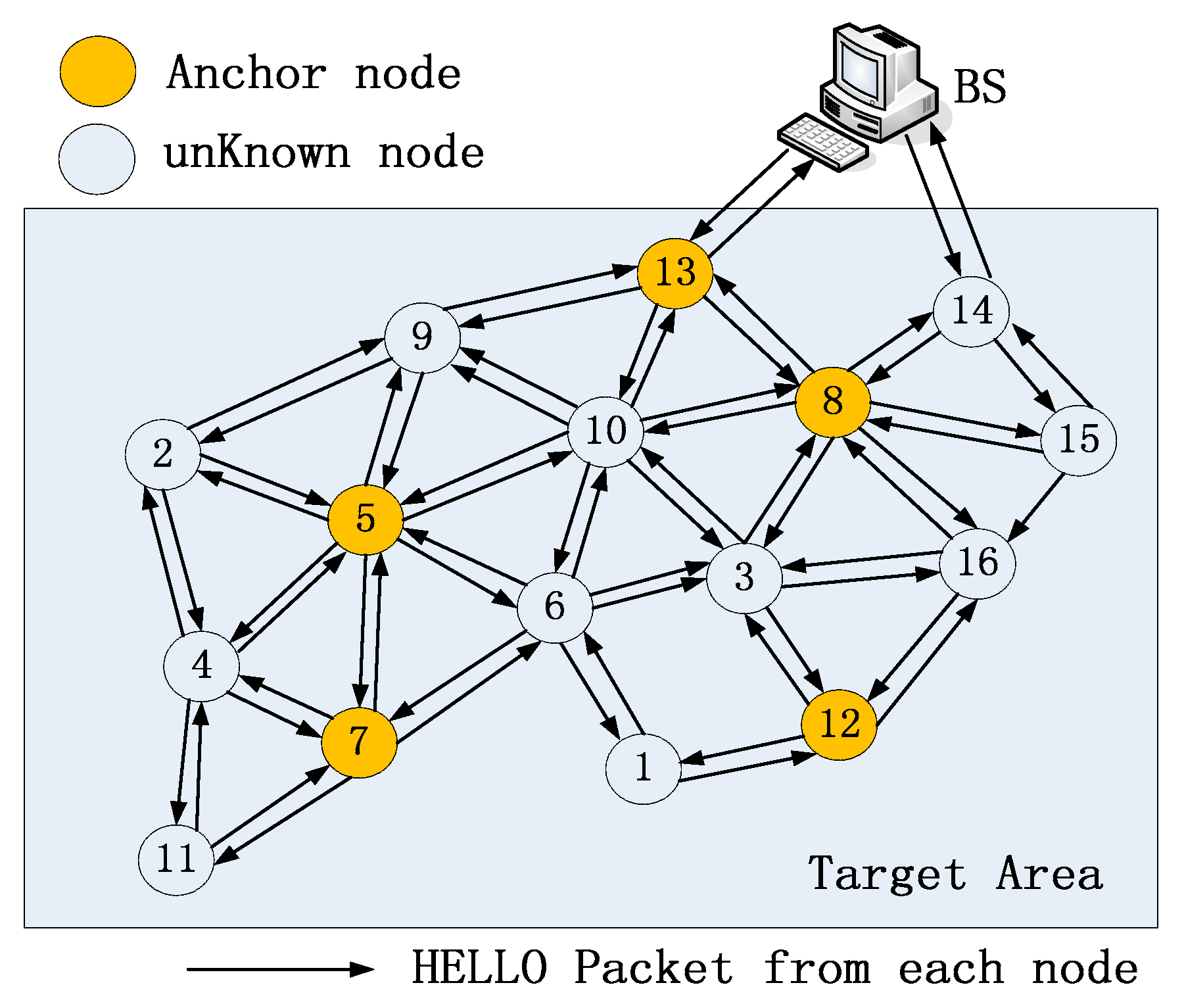


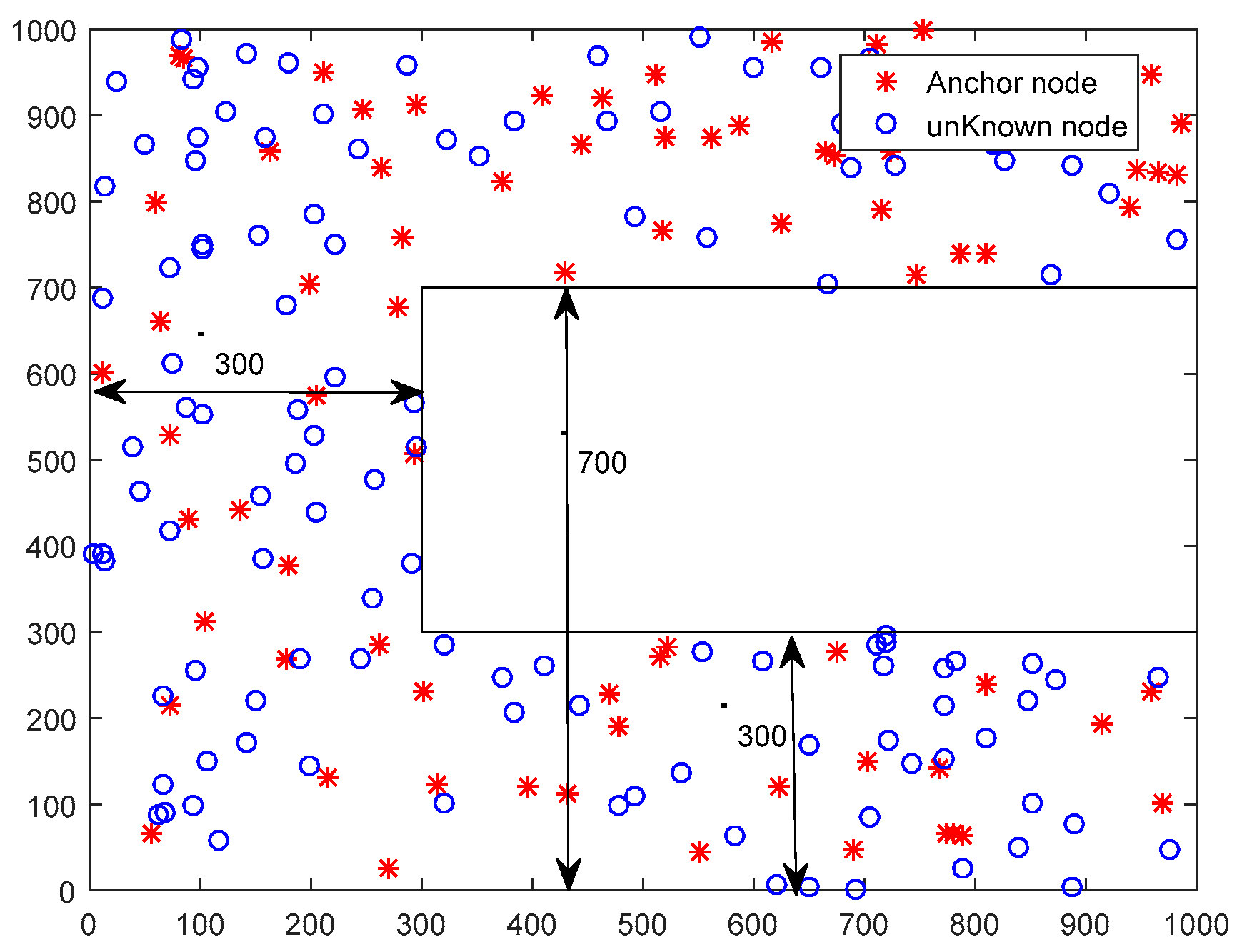
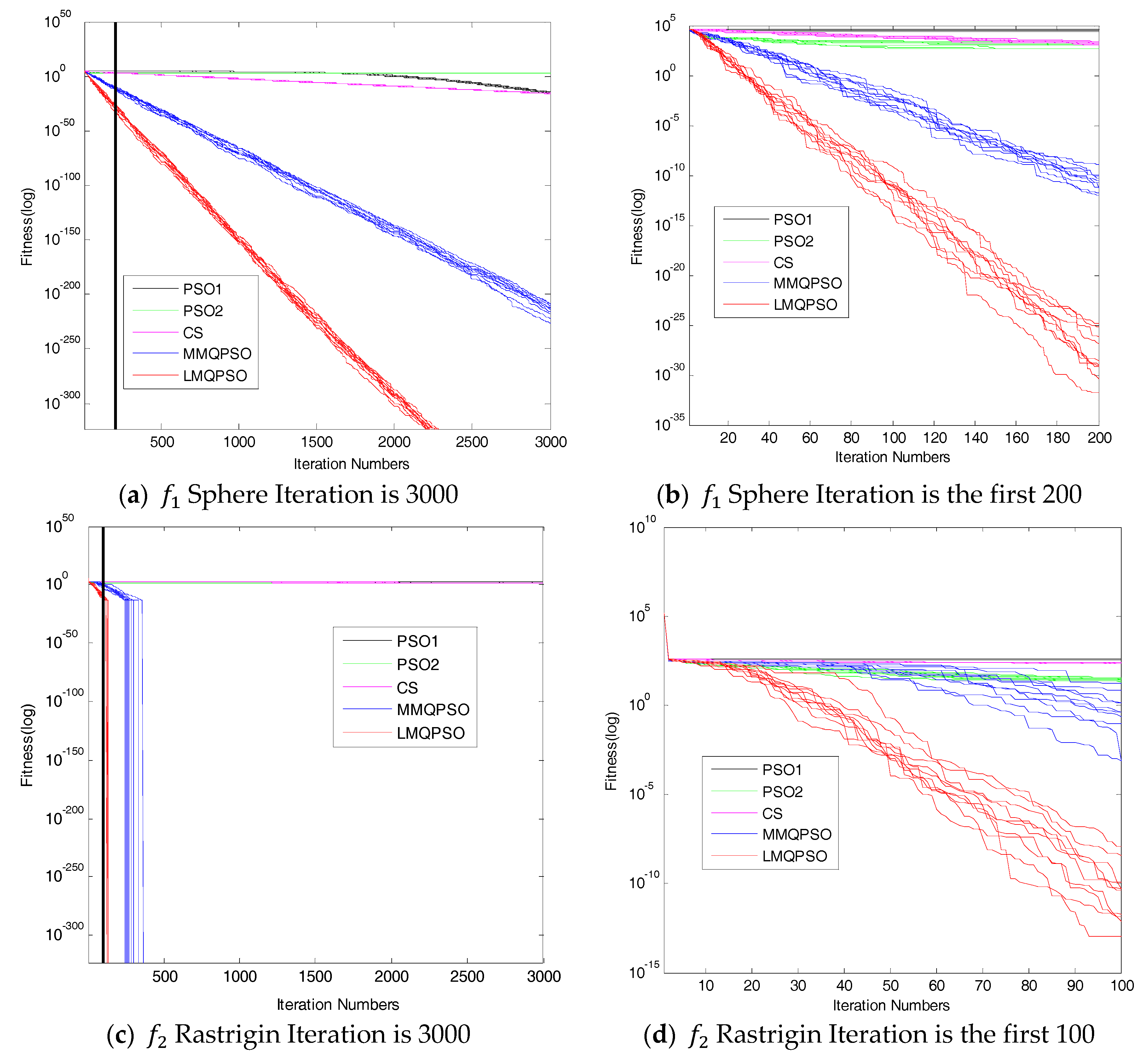
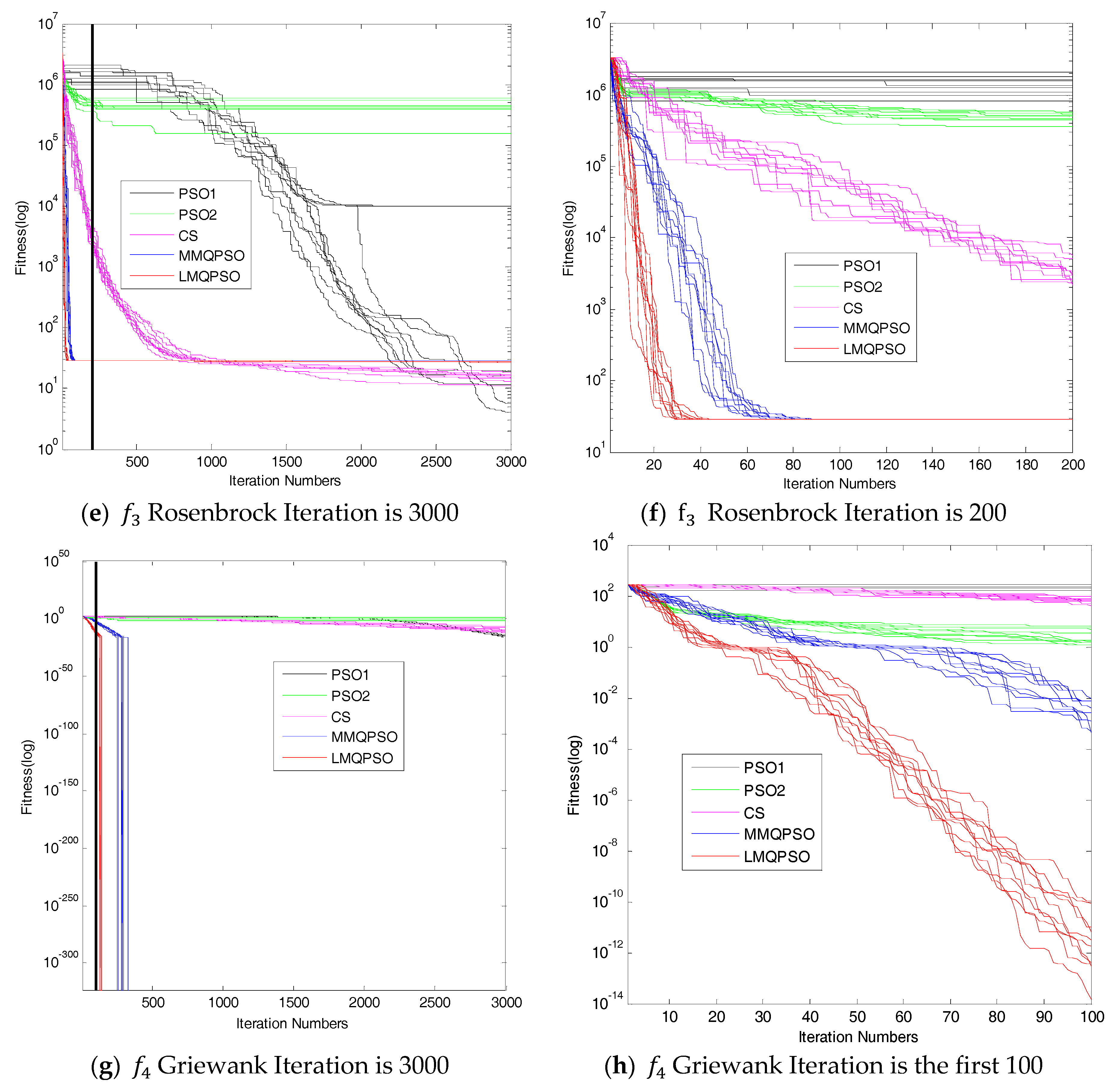
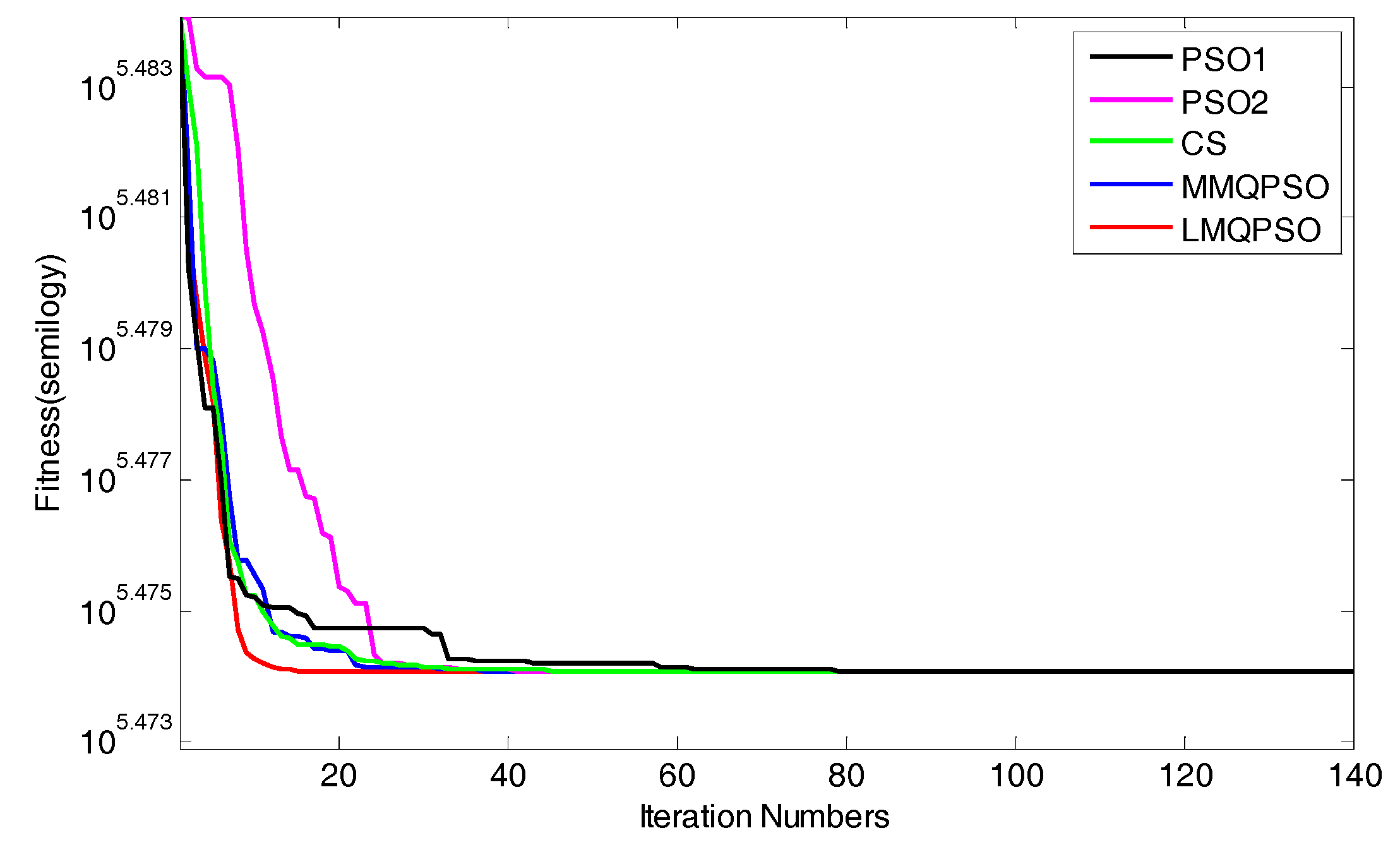
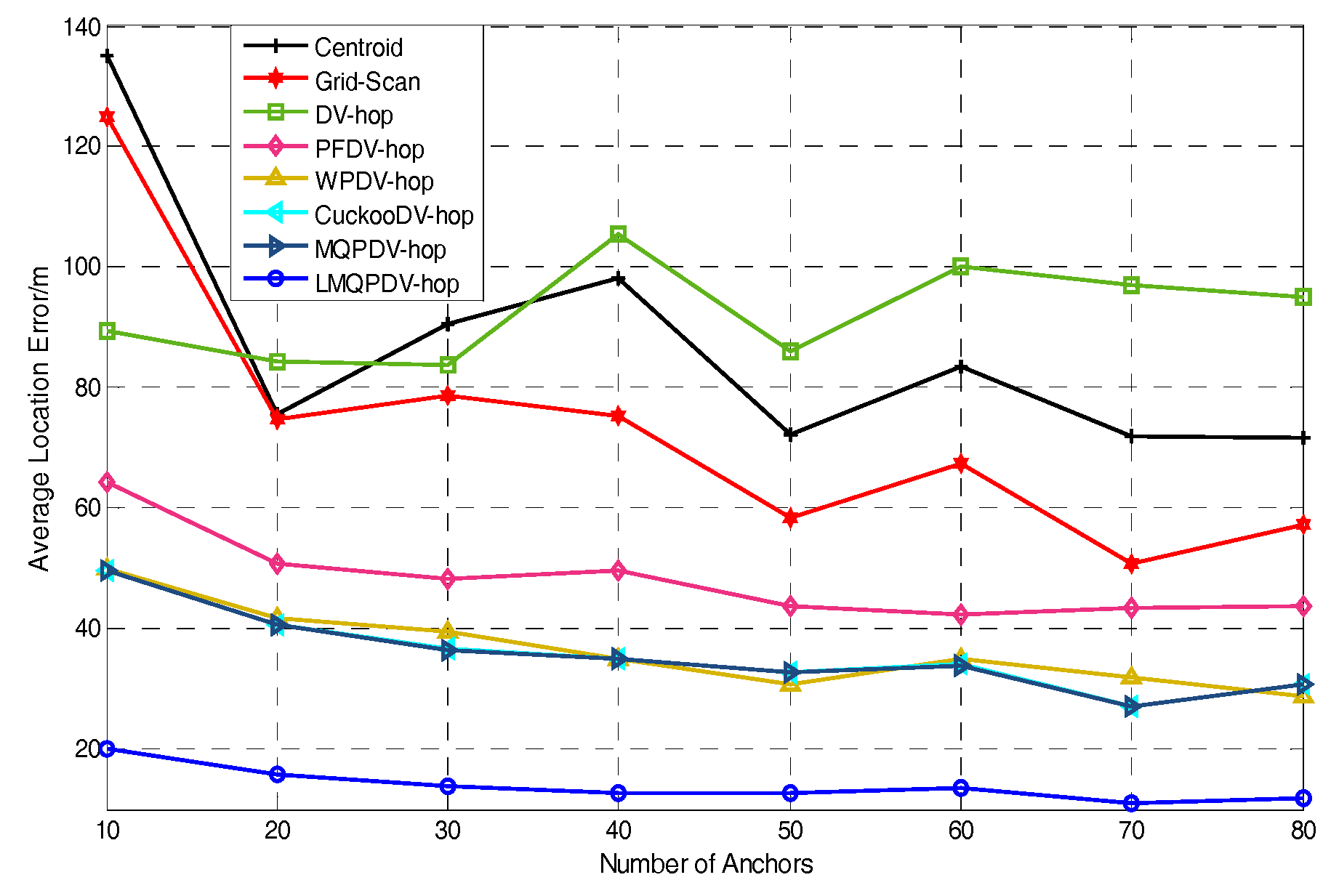

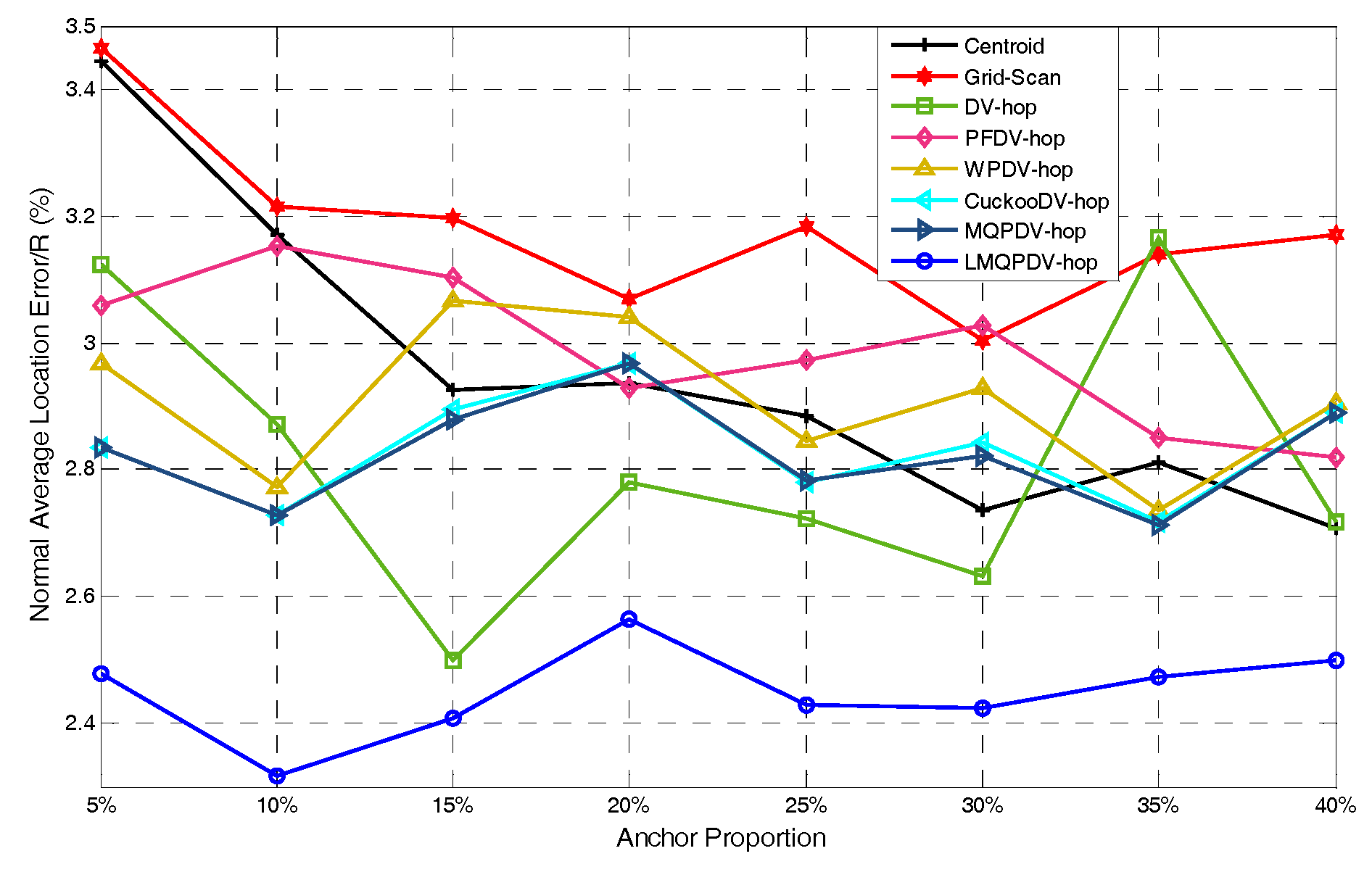
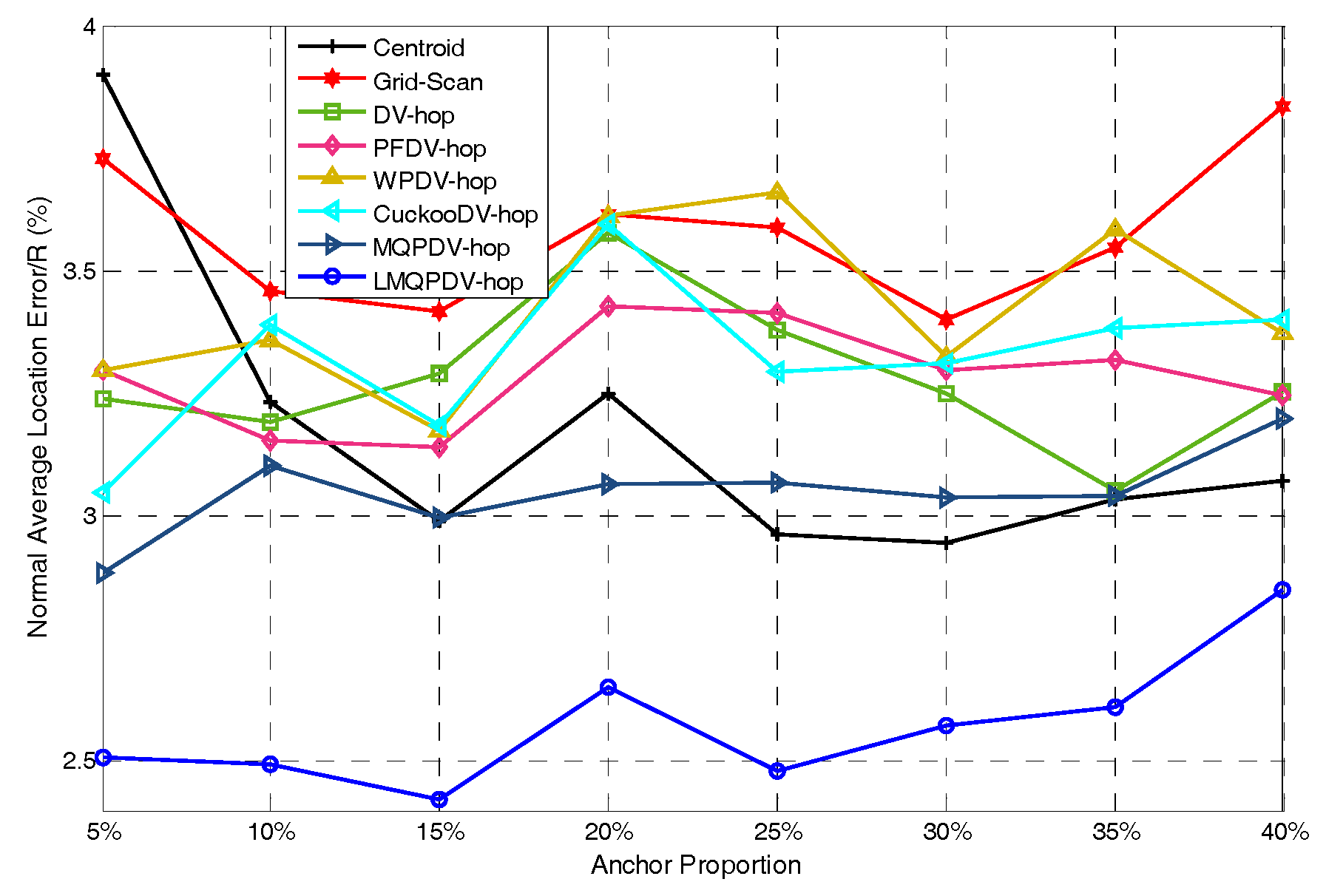
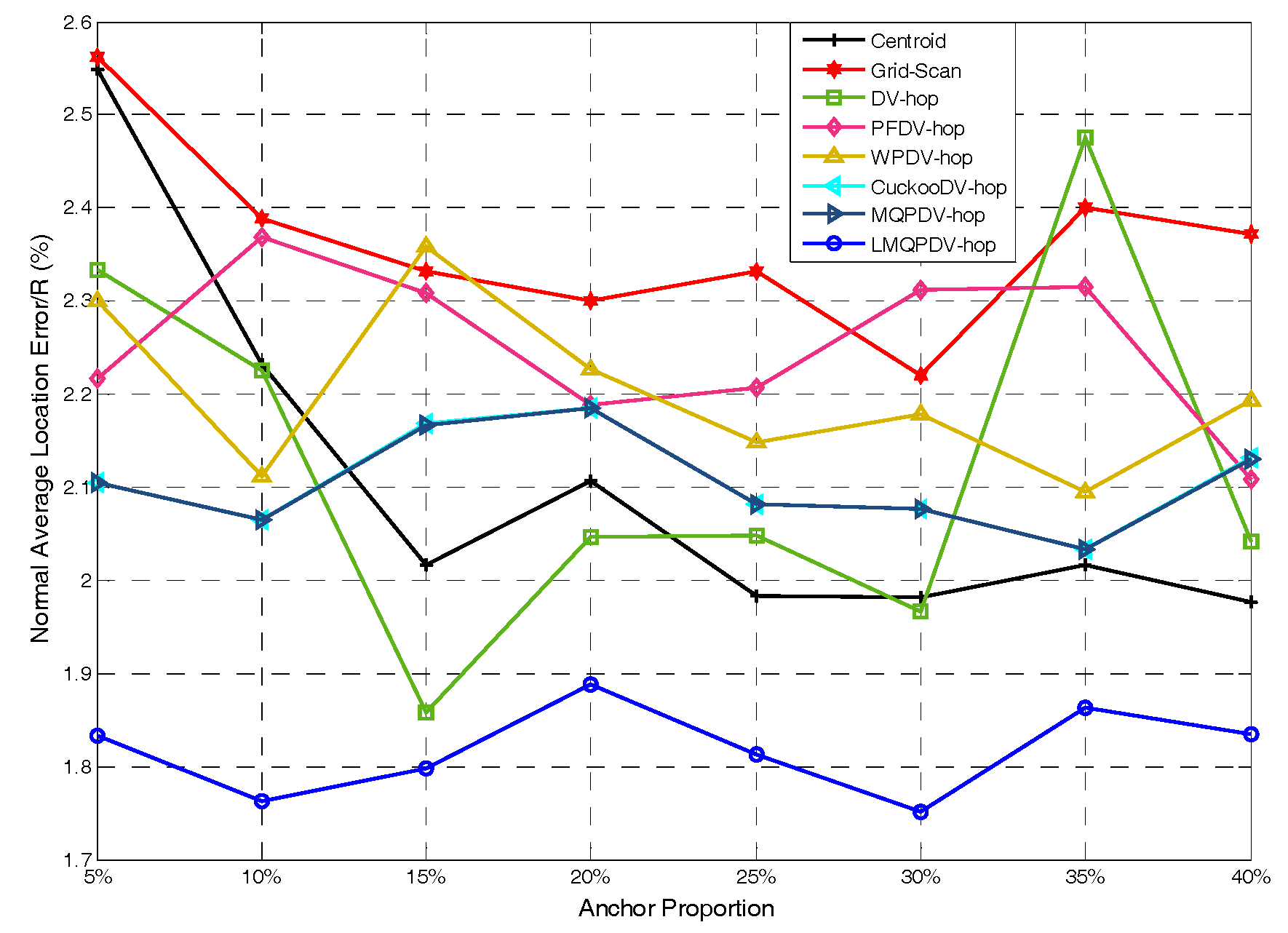
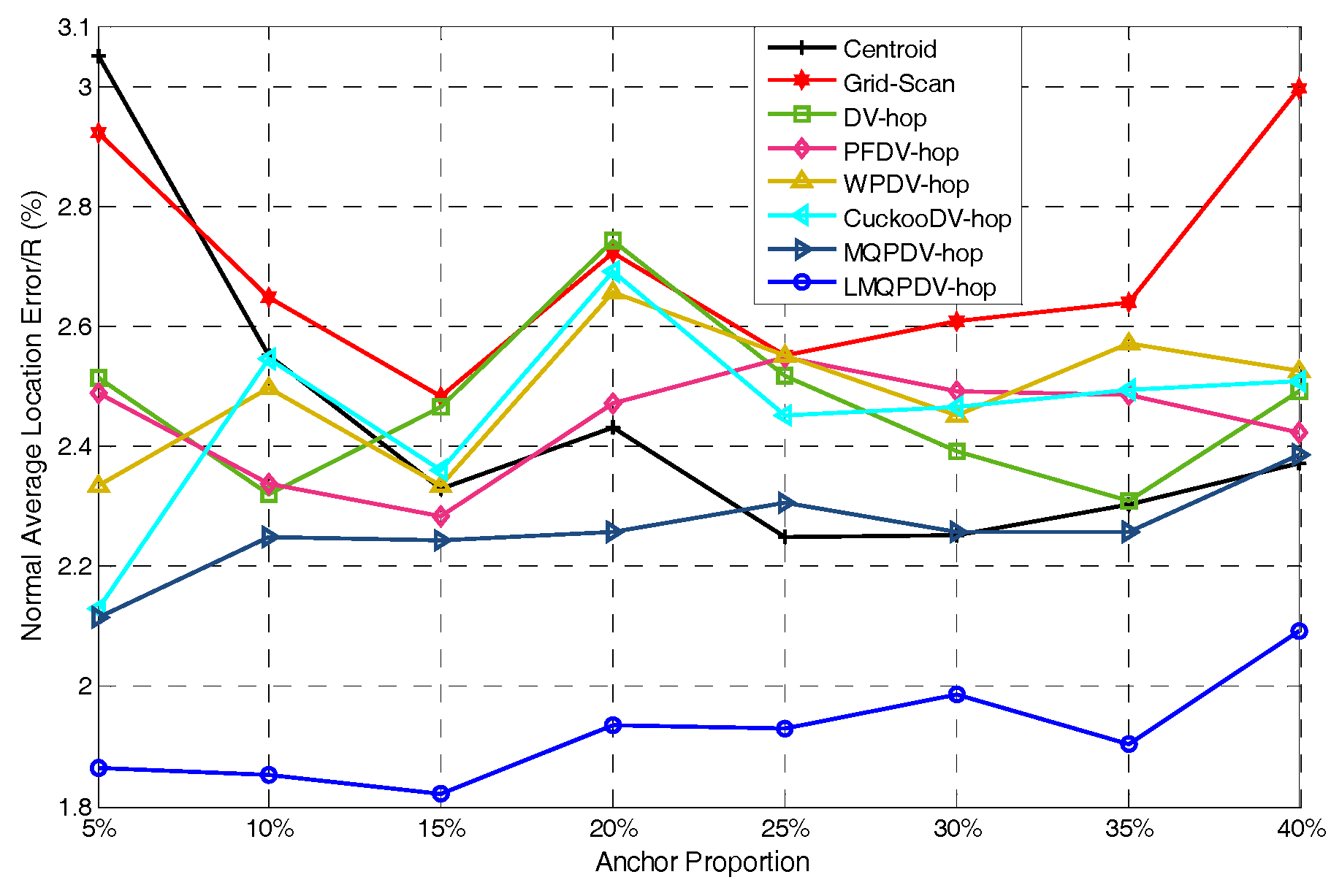
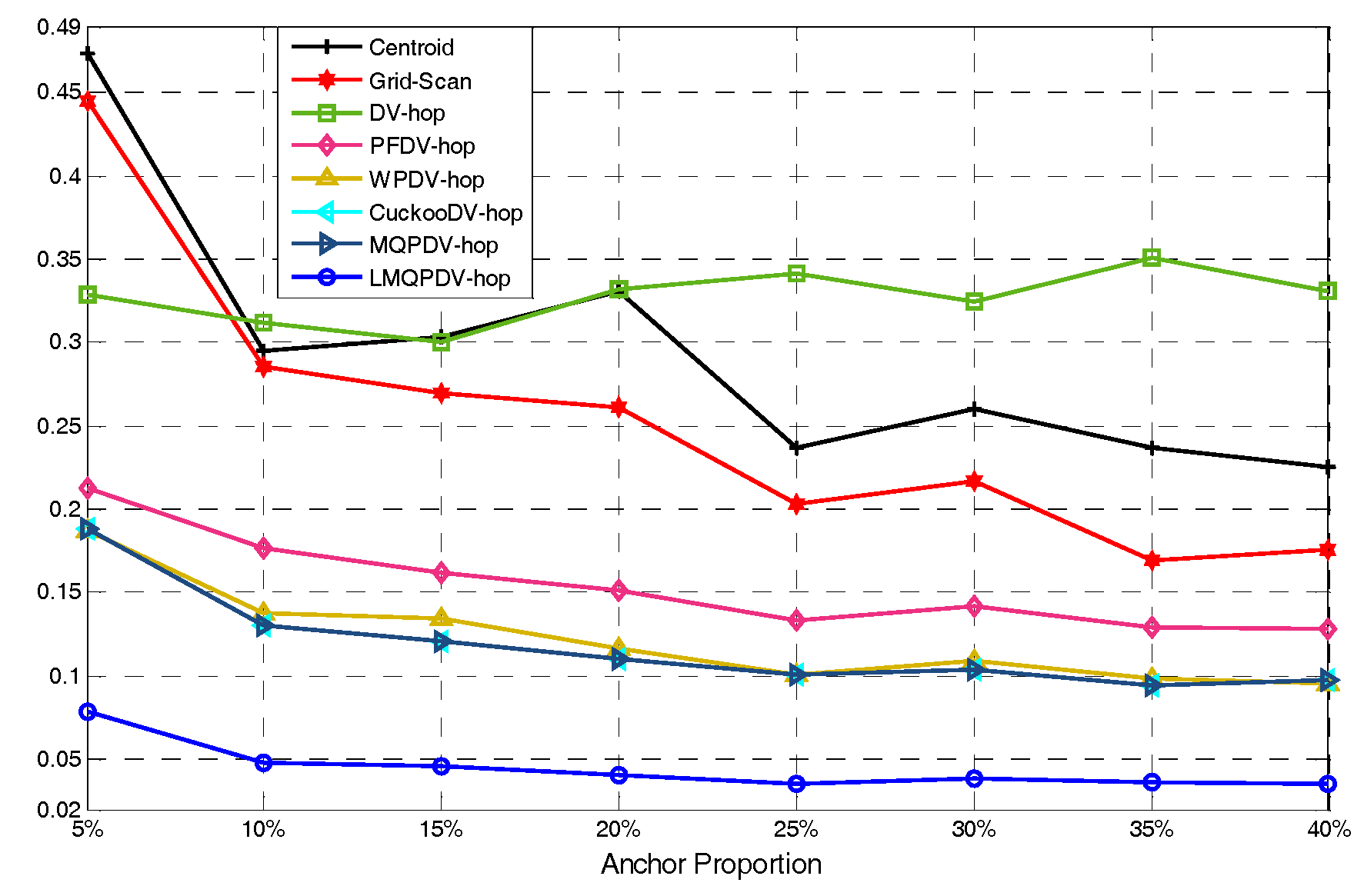
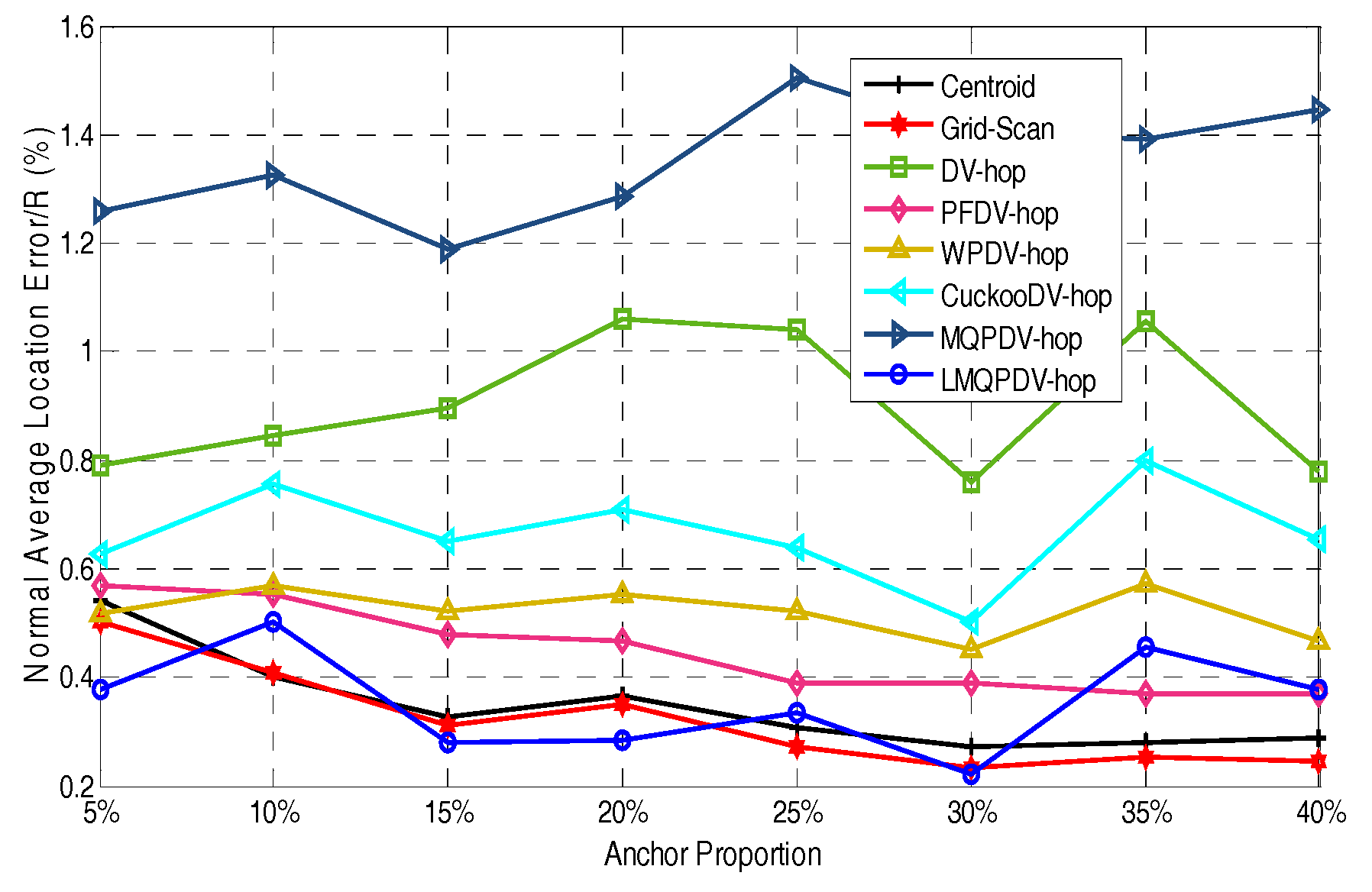
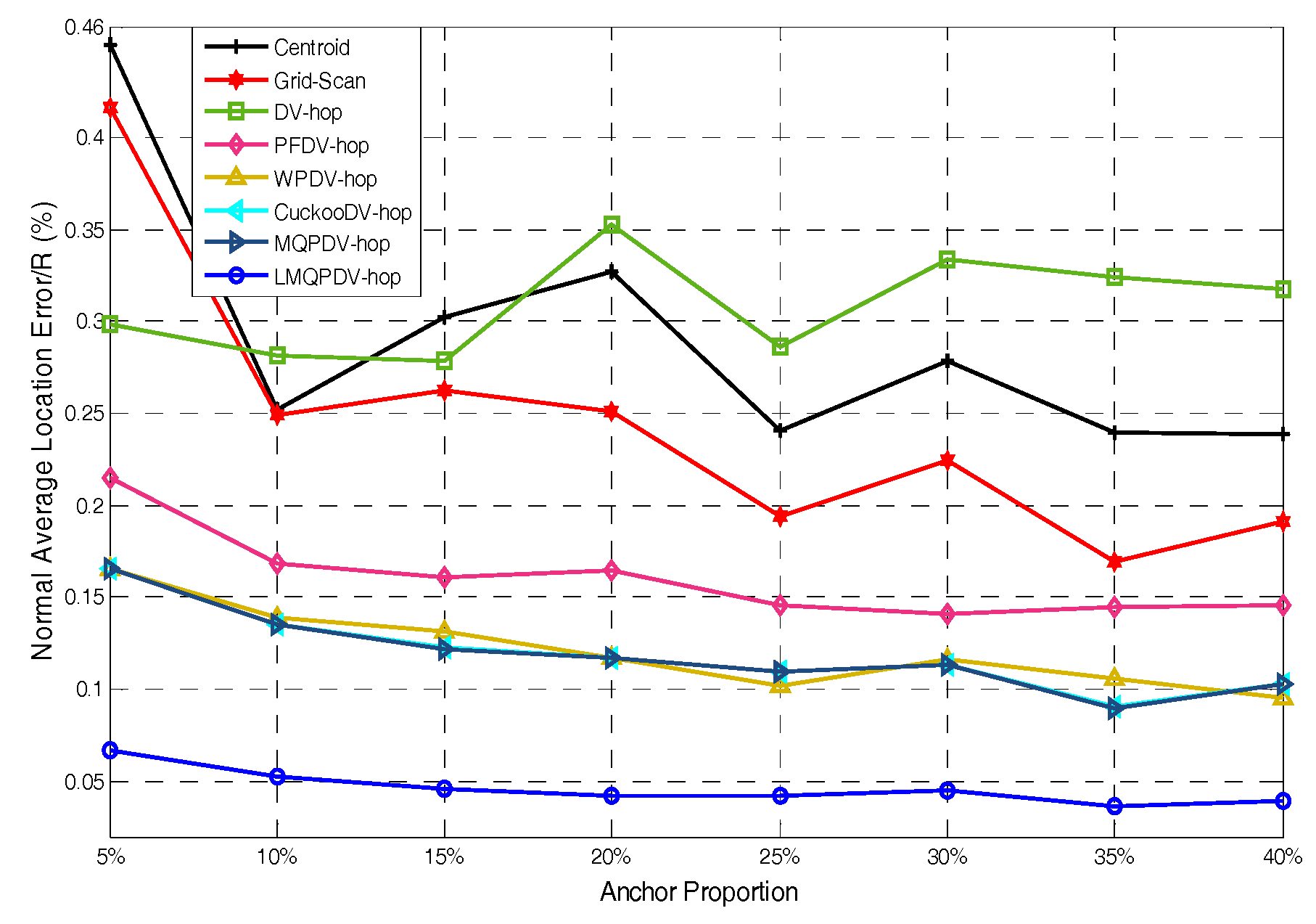
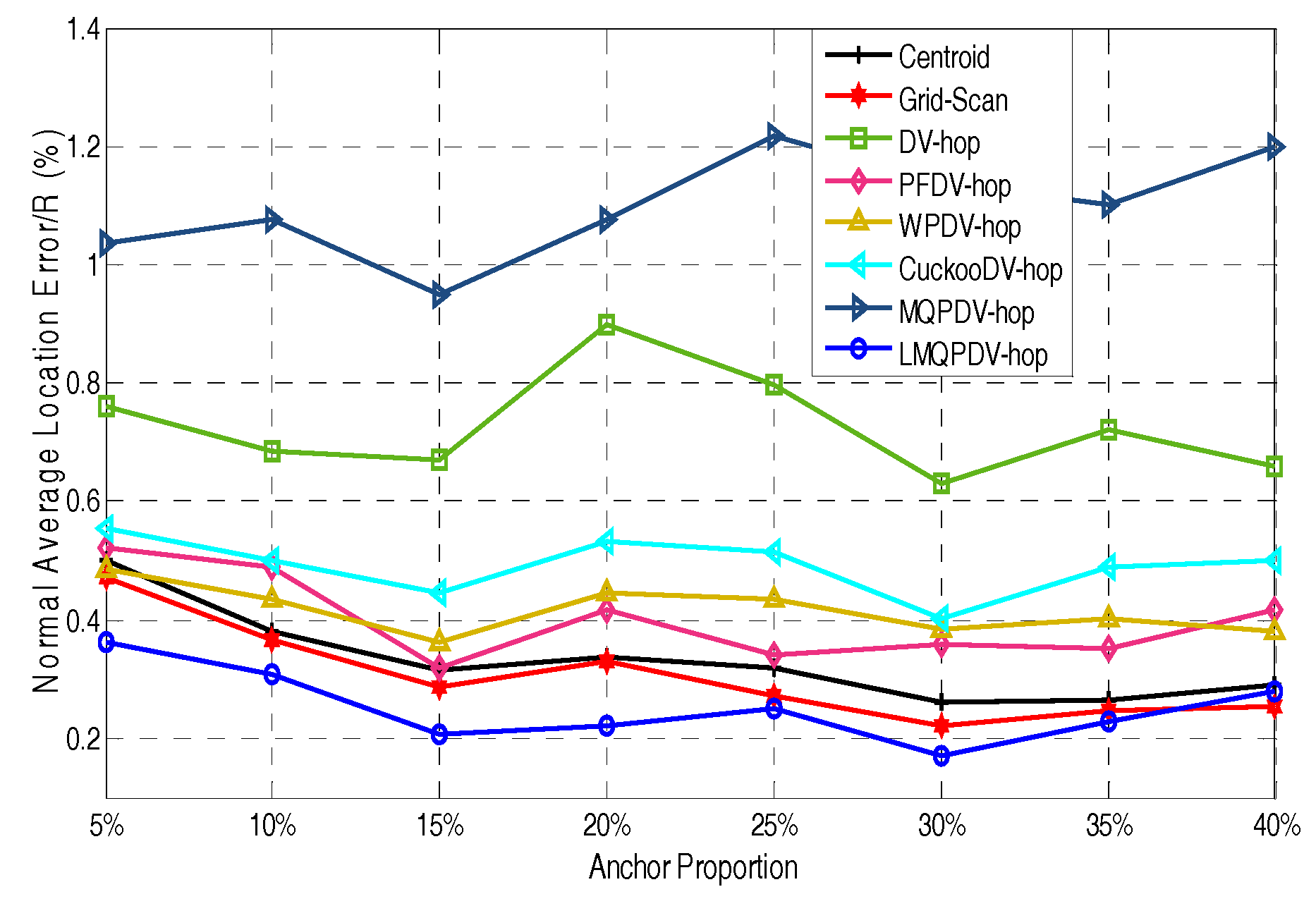

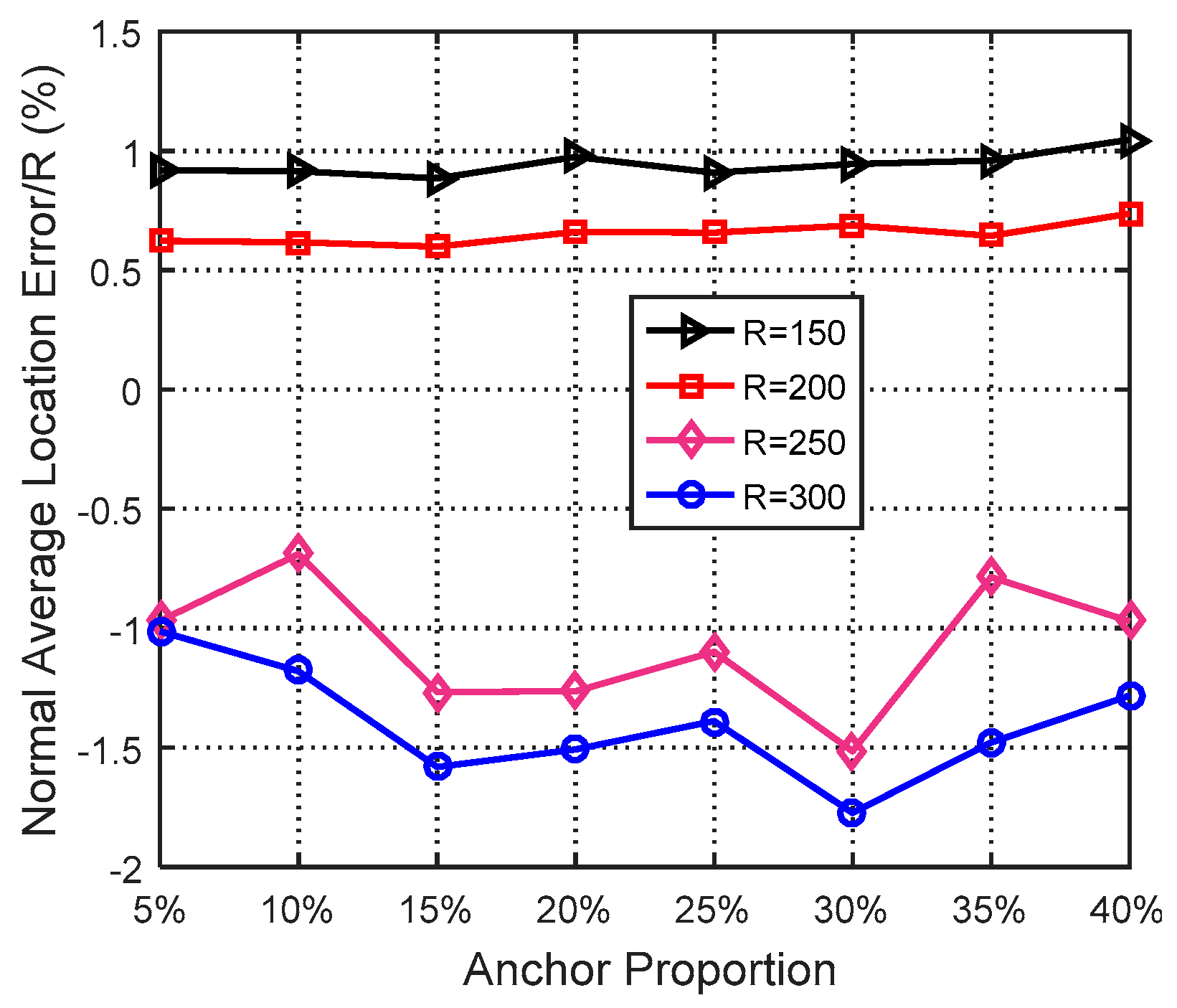


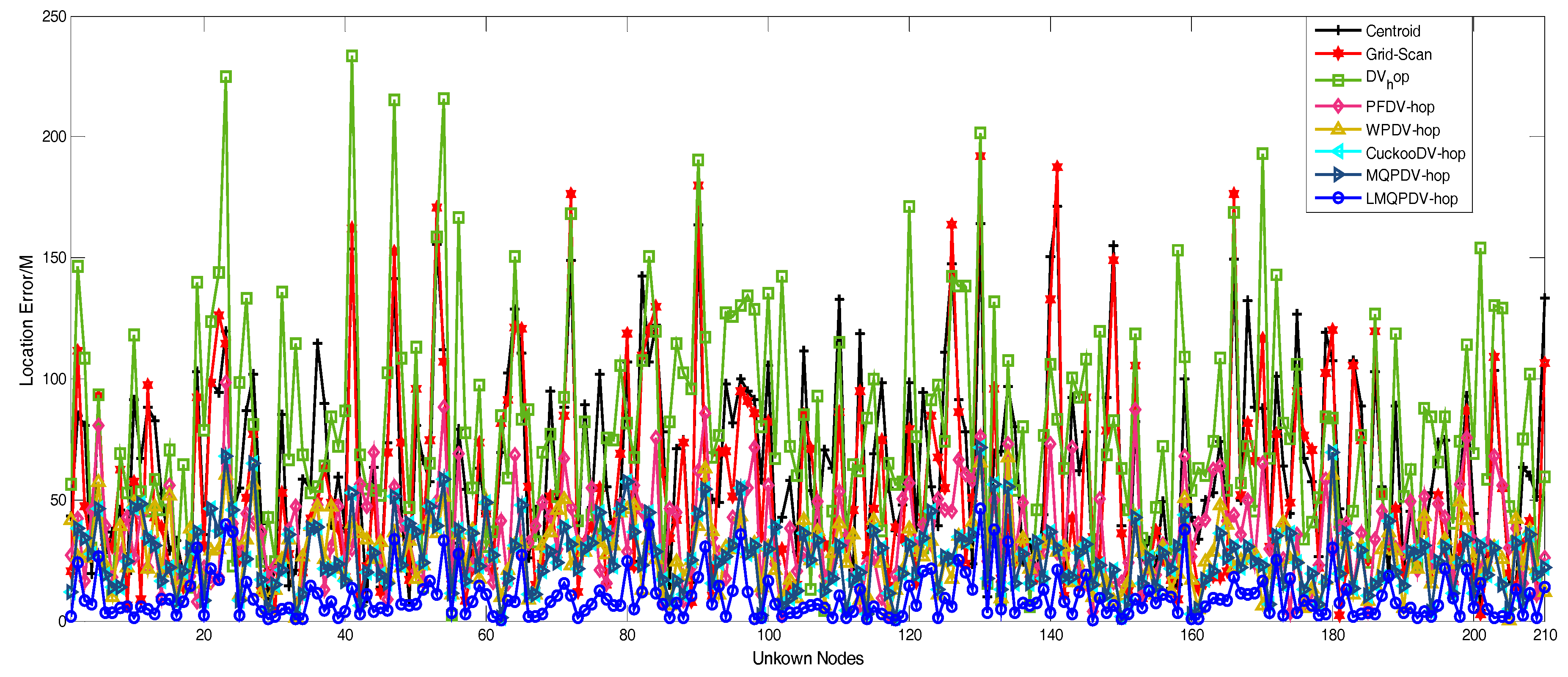

| Parameter | Values | Parameter | Values |
|---|---|---|---|
| WSN#1: shape area (L × L) WSN#2: C shape area | Communication Rang R | 150 m/200 m/250 m/300 m | |
| Nodes | 300 for Area1; 200 for Area2 | runs | 300 |
| Anchors | Area1:15/30/45/60/75/90/105/120 | , | 40 |
| Area2:10/20/30/40/50/60/70/80 | Max Iteration | 500 |
| F | PSO1 | PSO2 | CS | MMQPSO | LMQPSO | |||||
|---|---|---|---|---|---|---|---|---|---|---|
| Mean | SD | Mean | SD | Mean | SD | Mean | SD | Mean | SD | |
| 1.65 × 10−15 | 2.21 × 10−15 | 904.0898 | 506.6032 | 2.0397 × 10−16 | 8.11 × 10−17 | 3.39 × 10−213 | 6.76 × 10−210 | 0 | 0 | |
| 56.787 | 23.1209 | 25.2722 | 3.8452 | 52.2067 | 5.5055 | 0 | 0 | 0 | 0 | |
| 2018.1768 | 4.22 × 103 | 4.22 × 10−5 | 1.14 × 10−5 | 15.2697 | 2.0975 | 28.7063 | 0.011424 | 27.2872 | 0.28203 | |
| 0.011074 | 0.01344 | 1.8341 | 2.0568 | 2.81 × 10−8 | 8.42 × 10−8 | 0 | 0 | 0 | 0 | |
| Centroid | Grid-Scan | DV-hop | PFDV-hop | WPDV-hop | CuckooDV-hop | MMQPDV-hop | LMQPDV-hop | ||
|---|---|---|---|---|---|---|---|---|---|
| Anchors = 5% | R = 150 | 39 | 39 | 0 | 0 | 0 | 0 | 0 | 0 |
| R = 200 | 17 | 17 | 0 | 0 | 0 | 0 | 0 | 0 | |
| R = 250 | 2 | 2 | 0 | 0 | 0 | 0 | 0 | 0 | |
| R = 300 | 0 | 0 | 0 | 0 | 0 | 0 | 0 | 0 | |
| Anchors = 10% | R = 150 | 10 | 10 | 0 | 0 | 0 | 0 | 0 | 0 |
| R = 200 | 6 | 6 | 0 | 0 | 0 | 0 | 0 | 0 | |
| R = 250 | 2 | 2 | 0 | 0 | 0 | 0 | 0 | 0 | |
| R = 300 | 0 | 0 | 0 | 0 | 0 | 0 | 0 | 0 | |
| Anchors = 15% | R = 150 | 0 | 0 | 0 | 0 | 0 | 0 | 0 | 0 |
| R = 200 | 0 | 0 | 0 | 0 | 0 | 0 | 0 | 0 | |
| R = 250 | 0 | 0 | 0 | 0 | 0 | 0 | 0 | 0 | |
| R = 300 | 0 | 0 | 0 | 0 | 0 | 0 | 0 | 0 | |
| Anchors = 20% | R = 150 | 0 | 0 | 0 | 0 | 0 | 0 | 0 | 0 |
| R = 200 | 0 | 0 | 0 | 0 | 0 | 0 | 0 | 0 | |
| R = 250 | 0 | 0 | 0 | 0 | 0 | 0 | 0 | 0 | |
| R = 300 | 0 | 0 | 0 | 0 | 0 | 0 | 0 | 0 | |
| Anchors = 25% | R = 150 | 0 | 0 | 0 | 0 | 0 | 0 | 0 | 0 |
| R = 200 | 0 | 0 | 0 | 0 | 0 | 0 | 0 | 0 | |
| R = 250 | 0 | 0 | 0 | 0 | 0 | 0 | 0 | 0 | |
| R = 300 | 0 | 0 | 0 | 0 | 0 | 0 | 0 | 0 | |
| Anchors = 30% | R = 150 | 0 | 0 | 0 | 0 | 0 | 0 | 0 | 0 |
| R = 200 | 0 | 0 | 0 | 0 | 0 | 0 | 0 | 0 | |
| R = 250 | 0 | 0 | 0 | 0 | 0 | 0 | 0 | 0 | |
| R = 300 | 0 | 0 | 0 | 0 | 0 | 0 | 0 | 0 | |
| Anchors = 35% | R = 150 | 0 | 0 | 0 | 0 | 0 | 0 | 0 | 0 |
| R = 200 | 0 | 0 | 0 | 0 | 0 | 0 | 0 | 0 | |
| R = 250 | 0 | 0 | 0 | 0 | 0 | 0 | 0 | 0 | |
| R = 300 | 0 | 0 | 0 | 0 | 0 | 0 | 0 | 0 | |
| Anchors = 40% | R = 150 | 0 | 0 | 0 | 0 | 0 | 0 | 0 | 0 |
| R = 200 | 0 | 0 | 0 | 0 | 0 | 0 | 0 | 0 | |
| R = 250 | 0 | 0 | 0 | 0 | 0 | 0 | 0 | 0 | |
| R = 300 | 0 | 0 | 0 | 0 | 0 | 0 | 0 | 0 |
| Centroid | Grid-Scan | DV-hop | PFDV-hop | WPDV-hop | CuckooDV-hop | MMQPDV-hop | LMQPDV-hop | ||
|---|---|---|---|---|---|---|---|---|---|
| Anchors = 5% | R = 150 | 101 | 101 | 0 | 0 | 0 | 0 | 0 | 0 |
| R = 200 | 51 | 51 | 0 | 0 | 0 | 0 | 0 | 0 | |
| R = 250 | 47 | 47 | 0 | 0 | 0 | 0 | 0 | 0 | |
| R = 300 | 37 | 37 | 0 | 0 | 0 | 0 | 0 | 0 | |
| Anchors = 10% | R = 150 | 23 | 23 | 0 | 0 | 0 | 0 | 0 | 0 |
| R = 200 | 17 | 17 | 0 | 0 | 0 | 0 | 0 | 0 | |
| R = 250 | 8 | 8 | 0 | 0 | 0 | 0 | 0 | 0 | |
| R = 300 | 2 | 2 | 0 | 0 | 0 | 0 | 0 | 0 | |
| Anchors = 15% | R = 150 | 14 | 14 | 0 | 0 | 0 | 0 | 0 | 0 |
| R = 200 | 5 | 5 | 0 | 0 | 0 | 0 | 0 | 0 | |
| R = 250 | 3 | 3 | 0 | 0 | 0 | 0 | 0 | 0 | |
| R = 300 | 0 | 0 | 0 | 0 | 0 | 0 | |||
| Anchors = 20% | R = 150 | 10 | 10 | 0 | 0 | 0 | 0 | 0 | 0 |
| R = 200 | 0 | 0 | 0 | 0 | 0 | 0 | 0 | 0 | |
| R = 250 | 0 | 0 | 0 | 0 | 0 | 0 | 0 | 0 | |
| R = 300 | 0 | 0 | 0 | 0 | 0 | 0 | 0 | 0 | |
| Anchors = 25% | R = 150 | 7 | 7 | 0 | 0 | 0 | 0 | 0 | 0 |
| R = 200 | 0 | 0 | 0 | 0 | 0 | 0 | 0 | 0 | |
| R = 250 | 0 | 0 | 0 | 0 | 0 | 0 | 0 | 0 | |
| R = 300 | 0 | 0 | 0 | 0 | 0 | 0 | 0 | 0 | |
| Anchors = 30% | R = 150 | 0 | 0 | 0 | 0 | 0 | 0 | 0 | 0 |
| R = 200 | 0 | 0 | 0 | 0 | 0 | 0 | 0 | 0 | |
| R = 250 | 0 | 0 | 0 | 0 | 0 | 0 | 0 | 0 | |
| R = 300 | 0 | 0 | 0 | 0 | 0 | 0 | 0 | 0 | |
| Anchors = 35% | R = 150 | 0 | 0 | 0 | 0 | 0 | 0 | 0 | 0 |
| R = 200 | 0 | 0 | 0 | 0 | 0 | 0 | 0 | 0 | |
| R = 250 | 0 | 0 | 0 | 0 | 0 | 0 | 0 | 0 | |
| R = 300 | 0 | 0 | 0 | 0 | 0 | 0 | 0 | 0 | |
| Anchors = 40% | R = 150 | 0 | 0 | 0 | 0 | 0 | 0 | 0 | 0 |
| R = 200 | 0 | 0 | 0 | 0 | 0 | 0 | 0 | 0 | |
| R = 250 | 0 | 0 | 0 | 0 | 0 | 0 | 0 | 0 | |
| R = 300 | 0 | 0 | 0 | 0 | 0 | 0 | 0 | 0 |
| Algorithms | Mean (m) | SD | Median | Max | Min |
|---|---|---|---|---|---|
| Centroid | 64.9569 | 38.3392 | 56.7564 | 171.5318 | 4.3869 |
| Grid-Scan | 54.1673 | 41.7036 | 41.2522 | 192.1353 | 2.3492 |
| DV-Hop | 81.0914 | 44.9711 | 74.1953 | 233.7833 | 2.0677 |
| PSOPF | 35.4215 | 19.0896 | 31.5747 | 98.6248 | 2.1356 |
| WPDV-hop | 27.3898 | 13.3948 | 26.4115 | 67.3779 | 0.4255 |
| CuckooDV-hop | 25.9650 | 14.1097 | 24.4645 | 71.5169 | 1.0470 |
| MMQPDV-hop | 25.9654 | 14.1100 | 24.4645 | 71.5157 | 1.0470 |
| LMQPDV-hop | 9.5525 | 9.1495 | 6.9295 | 46.3154 | 0.2252 |
| Algorithms | Mean (m) | SD | Median | Max | Min |
|---|---|---|---|---|---|
| Centroid | 78.2976 | 40.0063 | 73.9095 | 187.5722 | 5.1489 |
| Grid-Scan | 66.1192 | 41.0146 | 58.0107 | 192.2525 | 1.2345 |
| DV-Hop | 188.7333 | 138.1515 | 146.0290 | 541.8573 | 8.8043 |
| PSOPF | 107.7841 | 77.1498 | 82.7475 | 314.4339 | 12.7221 |
| WPDV-hop | 115.5668 | 89.4502 | 76.7918 | 328.2392 | 2.5448 |
| CuckooDV-hop | 120.2391 | 82.393 | 91.0585 | 335.0295 | 2.4837 |
| MMQPDV-hop | 341.6534 | 208.1381 | 300.2621 | 918.1644 | 8.0499 |
| LMQPDV-hop | 50.9031 | 50.1564 | 35.4432 | 251.2712 | 0.1775 |
© 2019 by the authors. Licensee MDPI, Basel, Switzerland. This article is an open access article distributed under the terms and conditions of the Creative Commons Attribution (CC BY) license (http://creativecommons.org/licenses/by/4.0/).
Share and Cite
Yang, J.; Cai, Y.; Tang, D.; Liu, Z. A Novel Centralized Range-Free Static Node Localization Algorithm with Memetic Algorithm and Lévy Flight. Sensors 2019, 19, 3242. https://doi.org/10.3390/s19143242
Yang J, Cai Y, Tang D, Liu Z. A Novel Centralized Range-Free Static Node Localization Algorithm with Memetic Algorithm and Lévy Flight. Sensors. 2019; 19(14):3242. https://doi.org/10.3390/s19143242
Chicago/Turabian StyleYang, Jin, Yongming Cai, Deyu Tang, and Zhen Liu. 2019. "A Novel Centralized Range-Free Static Node Localization Algorithm with Memetic Algorithm and Lévy Flight" Sensors 19, no. 14: 3242. https://doi.org/10.3390/s19143242
APA StyleYang, J., Cai, Y., Tang, D., & Liu, Z. (2019). A Novel Centralized Range-Free Static Node Localization Algorithm with Memetic Algorithm and Lévy Flight. Sensors, 19(14), 3242. https://doi.org/10.3390/s19143242





